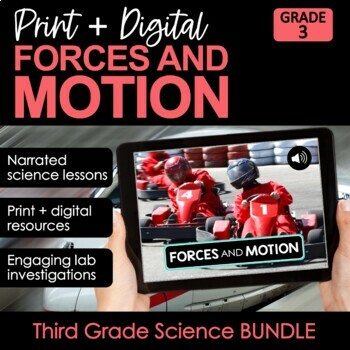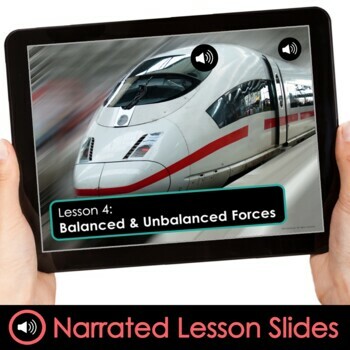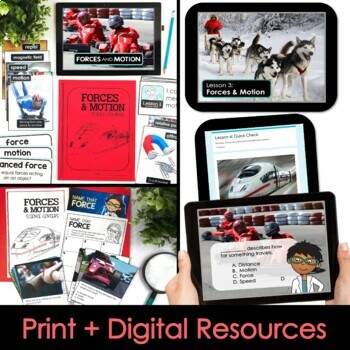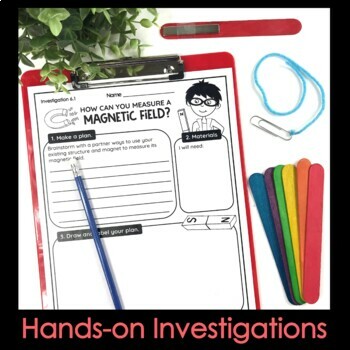Force and Motion Third Grade Science NGSS BUNDLE | Print + Digital
- Zip
- Google Apps™

What educators are saying
Products in this Bundle (2)
Description
This third grade science bundle includes both print and digital versions of Forces & Motion | NGSS. It includes EVERYTHING you need to teach, practice, experiment, and assess 27 days of NGSS aligned lessons on forces, motion, electricity, magnets, and magnetism.
Students learn:
· Patterns of Motion
· Measuring Motion
· Predicting Patterns
· Forces and Motion
· Contact & Noncontact Forces
· Chain Reactions
· Balanced & Unbalanced Forces
· Combined Forces
· Measuring Force
· Exploring Electricity
· Magnets, Magnetism, and Magnetic Fields
· Electromagnets
All of the activities are included in both a printable version and in digital format on Google Slides with narrated audio lessons. Detailed lesson plans, teacher binder, lab investigations and a multitude of lesson support materials are included in the printable version as well as on self-grading Google Forms.
With this bundle you have everything you need to seamlessly move between in-person teaching, hybrid classrooms or teaching virtually. The narrated audio lessons make it easy to differentiate for all of your readers and enable your students to listen and learn while working independently at school or virtually. The moveable, interactive digital activities make it easy and engaging for students to practice and apply what they are learning.
Included in this bundle:
Printable resources
-A complete Teacher’s Guide with a 28-day Pacing Guide
-Standards alignment pages with NGSS, TEKS, and CCSS for each lesson
-27 Days of detailed, scripted lesson plans. Each lesson takes 4-7 days to teach.
-7 Hands-on, investigations with lab procedures and step-by-step direction with photos.
-8 Partner activity labs
-6 Chapter Teaching Power Point to guide you through 23 engaging lessons with Turn and Talk partner discussion and Independent Activity slides after each lesson.
-Science Focus Wall with essential question and learning target posters
-Student science journal booklet with activity pages to support each lesson
-Vocabulary cards + full page posters
-Quick Check/Exit Tickets in 2 formats for each lesson (short written response or fill in the blank) with answer keys
-Final Assessment & Answer Keys
-Related videos and book list
Digital resources
6 Audio narrated lessons, 120 engaging Google Slides
Science journal activities on Google Slides
5 Self grading quizzes in multiple choice and short response format on Google Forms
Culminating unit test on Google Forms
Literacy & Math-Based Science Centers (in print + digital)
These games and task cards are ideal to add to your literacy centers to reinforce science content as students practice these skills:
Vocabulary
Cause & Effect
Visual Literacy
Mathematical Practice
LESSON TOPICS
Lesson 1.1 Position and Motion
Lesson 1.2 Measuring Motion
Lesson 1 Lab: How does shape affect motion?
Lesson 2.1 Patterns of Motion
Lesson 2.2 Patterns Can Change
Lesson 2 Lab: Predicting Patterns
Lesson 3.1 Forces and Motion
Lesson 3.2 Contact & Noncontact Forces
Lesson 3 Lab: Chain reactions
Lesson 4.1 Balanced and Unbalanced Forces
Lesson 4.2 Combined Forces
Lesson 4.3 Measuring Force
Lesson 4.4 the Floating Train
Lesson 4 Lab: How can forces hold up objects?
Lesson 5.1 Exploring Electricity
Lesson 5.2 Static Electricity
Lesson 5.3 Determining the Strength of a Force
Lesson 5 Lab: How can electric force levitate objects
Lesson 6.1 Magnets and Magnetism
Lesson 6.2 Magnetic Fields
Lesson 6.3 Electromagnets
Lesson 6 Lab 1: How can you measure the size of a magnetic field?
Lesson 6 Lab 2: How can magnets sort objects by weight?
*Please download both unit previews for details and pictures of everything included in this bundle.
See the entire 3rd grade science series! Click here
Happy teaching!
Linda Kamp
Around the Kampfire





